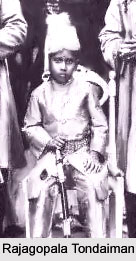 Rajagopala Tondaiman, formally known as His Highness Raja Sri Brahdamba Dasa Raja Sir Rajagopala Tondaiman Bahadur, was the 9th and last ruler or Raja of the princely state of Pudukkottai, which is currently located in the present district of Pudukkottai in Tamil Nadu. He reigned over the region from the period 24th October 1928 to 3rd March, 1948. The last ruler of Pudukkottai was born on 23rd June 1922 to the parents Prince Ramachandra Tondaiman of Pudukkottai and his second wife Mathusri Raja Srimathi Rani Janaki Ayi Sahib.
Rajagopala Tondaiman, formally known as His Highness Raja Sri Brahdamba Dasa Raja Sir Rajagopala Tondaiman Bahadur, was the 9th and last ruler or Raja of the princely state of Pudukkottai, which is currently located in the present district of Pudukkottai in Tamil Nadu. He reigned over the region from the period 24th October 1928 to 3rd March, 1948. The last ruler of Pudukkottai was born on 23rd June 1922 to the parents Prince Ramachandra Tondaiman of Pudukkottai and his second wife Mathusri Raja Srimathi Rani Janaki Ayi Sahib.
Early Life of Rajagopala Tondaiman
After the British Government of India refused to recognize Molly Fink, the Australian wife of His Highness Raja Sri Brahdamba Dasa Raja Sir Martanda Bhairava Tondaiman GCIE, the former ruler of the princely state of Pudukkottai, the royal couple then moved to Australia and later to London and Cannes in France. Eventually in the year 1921, Martanda Bhairava gave up the royal throne of Pudukkottai and nominated his brother Raghunatha Pallavarayar to administer and govern the princely state in his absence. After the death of Martanda Bhairava Tondaiman, Raja of Pudukkottai on 28th May 1928, Rajagopala Tondaiman, his 6 year old nephew, succeeded him on November 19, 1928. His official coronation ceremony was held on 24th October, 1928.
Rule of Rajagopala Tondaiman
He became the new Raja of the state, which was under the indirect rule of the British Empire in India. As he was still a minor at the time of his ascension, Rajagopala Tondaiman ruled over the territory under Raghunatha Pallavarayar, who served as the regent of the state until February 1929. Later from February 1929 to January 1944, Pudukkottai state was administered by a council of regency that was appointed by the British Government of India. Raja Sri Rajagopala Tondaiman was invested with full ruling powers after he reached the age of majority. He took over the governance and administration of the princely state on 17th January 1944.
After India attained independence from the British government in August 1947, Rajagopala Tondaiman acceded the state of Pudukkottai to the Union of India on 3rd March 1948. The former Pudukkottai state was merged with the newly formed Dominion of India and was included into Trichinopoly district of the Madras Presidency.
Personal Life of Rajagopala Tondaiman
He served as the President of the Pudukottai Recreation Club (PRC), Tamil Nadu Cricket Association (TNCA) and Kodaikanal Boat and Rowing Club. Rajagopala Tondaiman of Pudukkottai died on 16th January, 1997 in Chennai, India, at the age of 74.
Honours of Rajagopala Tondaiman
His Highness Raja Sri Brahdamba Dasa Raja Sir Rajagopala Tondaiman Bahadur was honoured with the George V Silver Jubilee Medal in 1935, George VI Coronation Medal in 1937 and the Indian Independence Medal in the year 1948.



















